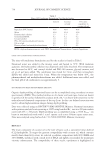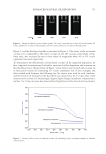636 JOURNAL OF COSMETIC SCIENCE database. In shotgun metagenomics, the entire DNA sample is putatively sequenced without amplification. The main issues with shotgun metagenomics are the lack of organisms in the current databases and the lack of any quantitative nature. The amplicon databases, referred to as 16S for bacteria and ITS (intergenic transcribed spacer region) for fungi, are much more comprehensive than full metagenomic databases, particularly for eukaryotic organisms. Keep in mind that microorganisms are being discovered at a phenomenal rate, with many still unknown. When sequences are not found in the databases, they are clustered into “dark matter” and disregarded. Hence, there is often more uncharacterized dark matter in metagenomics than in amplicon sequencing. Finally, in shotgun metagenomics, the output is diversity, the relative abundance of population members. This does not provide any information on quantity of microbes, which remains an important part of microbiology. Using both techniques, one finds that the human skin microbiome generally consists of 93–97% bacterial genomes and 3–7% fungal genomes, and this very much depends on the body site (with fungi populating the oily sebaceous areas, including scalp, face, and back). The vast majority of the fungal community are Malassezia, with a more diverse bacterial community dominated by Cutibacterium acnes various Staphylococci (4,8). FUNGI AND MALASSEZIA Fungi is a vast kingdom. There are many different types, including mushrooms, mold, smut, and rusts. A famous toxic mold is Stachybotrys chartarum, a very dangerous mold to have in one’s basement. Smuts and rusts are major agricultural pests, causing billions of dollars per year in damage to crops such as rice, corn, and citrus. Malassezia are yeasts, and, importantly, closely related to many plant pathogens. There are 18 known Malassezia species and dozens of functionally diverse strains (9). This article now returns to the topic of nonculture-based microbiome detection methods: amplicon and metagenomics sequencing. With either method, the percent of the microbiome defined above is based as the number of genomes, implying there are 10 to 100 times more bacterial cells per skin unit area than fungal cells (8,10). An important difference is that fungi are gigantic compared to bacteria. The volume of a sphere varies with the cube of the radius and the volume of the cylinder with the square of the radius. So, when something is a few microns larger in diameter, it is tremendously larger in volume or biomass. Malassezia globosa or Malassezia furfur is conservatively a thousand times larger than bacteria (11). If there are 100 times more bacterial cells, then there are almost certainly at least as much interactive biomass from fungi. The biomass interacts with us, not the genome. Another thing about mycology is that few people study it. Less than 10% of the microbiome publications consider fungi, and when one adds in skin, you get less than 1% of microbiome publications relating to skin fungi. In fact, fungi are so poorly investigated that in 2017, some students in California went to the grocery store and bought a packet of porcini mushrooms and sequenced their genomes. They identified seven previously undescribed species in a porcini packet on a grocery store shelf. Finally, mycology has been catching up in importance in large part because of public awareness and interaction, including since it became apparent that the Earth is a lot more like the Middle Earth in J.R.R. Tolkien’s world because plants actually talk to each other through an underground fungal mycelium.
637 THE ROLE OF THE SCALP MICROBIOME IN HEALTH AND DISEASE DANDRUFF Now that we understand Malassezia and fungi, this paper will now discuss dandruff. Dandruff is big business—making the skincare industry a lot of money. The market associated with skin microbiology is estimated at more than $20 billion USD per year, with $5 billion of that being anti-dandruff shampoo alone. This makes dandruff a significant problem that accounts for a large percentage of dermatologist visits and a health care burden. As so many research publications focus on the gut and bacteria, skin eukaryotes are poorly understood. This is an exploitable knowledge gap and, hopefully, we can learn to exploit skin mycology to drive business and improve human health. Dandruff represents a less severe version of seborrheic dermatitis, but both are the result of a similar aetiology (12). Dandruff consists of scalp flaking and pruritis (itch). Seborrheic dermatitis also includes visible irritation and may extend beyond the scalp to the eyebrows, nasal labial fold, and beard. But dandruff is more than flaking and itch. The stratum corneum is completely disrupted, mixed up, and disorganized and completely unable to perform its function, which is to protect us from what is outside and to keep our water in (13). To understand what causes dandruff, it is useful to initially review historic treatment paradigms. Historically, the most effective materials used to treat dandruff had one commonality: antifungal efficacy. This may lead us to hypothesize that fungi are involved in dandruff genesis. As the scalp microbiome is dominated by Malassezia, it would also make sense that Malassezia that might be important in causing dandruff. The problem here is that Malassezia are found on a healthy scalp as well as one with dandruff. Many hours and dollars have been sacrificed investigating the cause of dandruff to enable better treatment design. Initially, when it was discovered in 1994 that Malassezia consisted of multiple species, we were convinced we would be able to identify a causative species and thereby target the right Malassezia (14). We executed a parallel group clinical study and compared dandruff sufferers with an inherent scalp flaking score (ASFS) of greater than 24 to normal subjects with an inherent scalp flaking score of less than 10. Unfortunately, the two groups were the same, and everyone had the same scalp microbiome (15). If this is correct, and it remains so even today, how can Malassezia be the cause of dandruff? MALASSEZIA AND THEIR ROLE ON SKIN COMMENSALISM There are multiple types of microbe–host relationship terms: commensalism, in which one partner benefits but the other is unaffected pathogenicity, in which one benefits and the other is harmed and mutualism, in which both benefit (16). It has been long known that Malassezia inhabit the skin of all humans, with both healthy and diseased skin. In the absence of any other data, the default interpretation would be that Malassezia benefit from living on us, utilizing us as a food source and biological niche with no obvious benefit or harm, leading to definition of the relationship as commensal. Indeed, virtually all the technical literature prior to 2000 would classify Malassezia as commensals on human skin, perhaps occasionally being referred to an “opportunistic pathogen.” Very likely, in some instances, this is a correct assumption. In other cases, we now think it likely that a more complicated relationship exists.
Purchased for the exclusive use of nofirst nolast (unknown) From: SCC Media Library & Resource Center (library.scconline.org)






































































































































